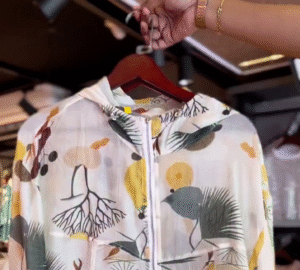India, a country with a soul woven in threads and textures, boasts one of the richest textile heritages in the world. From the snowy peaks of Kashmir to the sun-kissed coasts of Tamil Nadu, each region weaves not just fabric, but history, identity, and artistry. While we often celebrate Banarasi silks or Chikankari, there’s a world of rare and exquisite weaves that deserve the spotlight in every fashion lover’s wardrobe.
Let’s unravel some of India’s rarest, most underrated weaves you should consider adding to your personal collection — not just for their beauty, but for the legacy they carry.
1. 🧵 Mashru (Gujarat & Rajasthan)
Blend of Silk & Cotton
Once worn by royalty, Mashru is a blend of luxury and comfort. The outer layer is rich silk, while the inner is soft cotton — making it ideal for hot climates.
Why it’s rare: With a limited number of artisans weaving Mashru today, authentic pieces are hard to find.
Style idea: A Mashru jacket or blouse adds a luxurious pop to even the simplest saree or jeans.

2. 🐚 Sujani (Bihar)
Embroidered Quilt Weave
More than just a fabric, Sujani tells stories. Traditionally made by stitching together old saris with fine embroidery, each piece is a canvas of folklore, myth, and personal tales.
Why it’s rare: It’s a dying form, being revived by select NGOs and rural craft clusters.
Style idea: Use Sujani as jackets, stoles, or even wall art.

3. 💫 Sikalnayakanpettai Silk (Tamil Nadu)
Ancient Temple Weave
Originating from a single village in Tamil Nadu, this lesser-known silk weave is woven using traditional pit looms and adorned with delicate motifs often inspired by temple art.
Why it’s rare: Only a few families still carry on this technique, making the fabric extremely exclusive.
Style idea: Perfect for heritage sarees or bridal heirlooms.
4. 🌾 Kharad (Kutch, Gujarat)
Woollen Flat-Weave Rugs
Though not a textile for apparel, Kharad is an artisan treasure made using camel wool. It showcases geometric motifs and earthy hues.
Why it’s rare: With fewer than 10 families still making Kharad rugs, it’s on the verge of extinction.
Style idea: Use it as a decorative shawl or ethnic home accent.

5. 🌿 Pashmina (Kashmir)
Softest Wool in the World
Yes, you’ve heard of it — but authentic Pashmina is incredibly rare. Derived from Changthangi goats of Ladakh, real pashmina is hand-spun and handwoven.
Why it’s rare: Machine-made imitations flood the market, but handmade ones are few and precious.
Style idea: Wrap a classic pashmina shawl around a simple dress and let it do all the talking.
6. 🦚 Garad Silk (West Bengal)
Sacred and Subtle
Worn traditionally by Bengali women during religious rituals, Garad silk is undyed mulberry silk with red borders. Its elegance lies in its restraint.
Why it’s rare: Pure Garad with natural dyes is hard to source as synthetic versions have taken over.
Style idea: Wear for pujas, festivals, or minimalist weddings.

7. 🧶 Tharu Weave (Uttar Pradesh & Nepal Border)
Tribal Textile Art
Woven by the Tharu tribe, these fabrics are rustic, durable, and adorned with tribal embroidery and mirror work.
Why it’s rare: The weaving tradition is passed orally and practiced by a few tribal women today.
Style idea: Ideal for bags, boho jackets, or earthy skirts.
8. 🌀 Mooga Silk (Assam)
Golden Hue, Natural Shine
A silk unique to Assam, Mooga is naturally golden-yellow and gets shinier with each wash. It’s durable and considered a symbol of status and purity.
Why it’s rare: Limited to Assam, the silkworms that produce Mooga are extremely climate-sensitive.
Style idea: Drape it as a statement saree or turn it into an heirloom dupatta.

9. 🌊 Sungudi (Madurai, Tamil Nadu)
Tie-Dye Meets Temple Motifs
A vibrant hand-tied and dyed cotton fabric traditionally worn by South Indian women. The designs mimic temple pillars, peacocks, and flora.
Why it’s rare: Mechanisation has reduced hand-made production drastically.
Style idea: Ideal for hot summers — as cotton sarees or breezy kurtas.
10. 🔶 Patola (Double Ikat – Gujarat)
Intricate Weaving Masterpiece
A Patola saree takes months — sometimes years — to create. It’s woven using a double ikat technique where both warp and weft are tie-dyed before weaving.
Why it’s rare: Only a handful of families in Patan, Gujarat, still know the exact process.
Style idea: If you own one, preserve it — it’s not fashion, it’s art.

🧵 Why Owning Rare Indian Weaves Matters
- Sustainability: You support handwoven, eco-conscious textiles.
- Heritage: These fabrics carry generational stories.
- Uniqueness: No two pieces are exactly alike.
- Empowerment: You uplift artisans who are the custodians of India’s craft legacy.
✨ Final Thoughts
If your wardrobe is still filled with mass-produced silks and factory-made prints, it’s time to explore the rich and rare. Owning Indian handloom is not just about fashion — it’s about owning a piece of history.
So next time you go saree or fabric shopping, ask this: “What’s the story behind this weave?”
🛈 Disclaimer
Informational Purposes Only All content on fashiontagz.com is provided solely for educational and informational purposes. We do not sell or promote counterfeit products. Our goal is to help consumers identify, compare, and make informed decisions about fashion and accessories.








